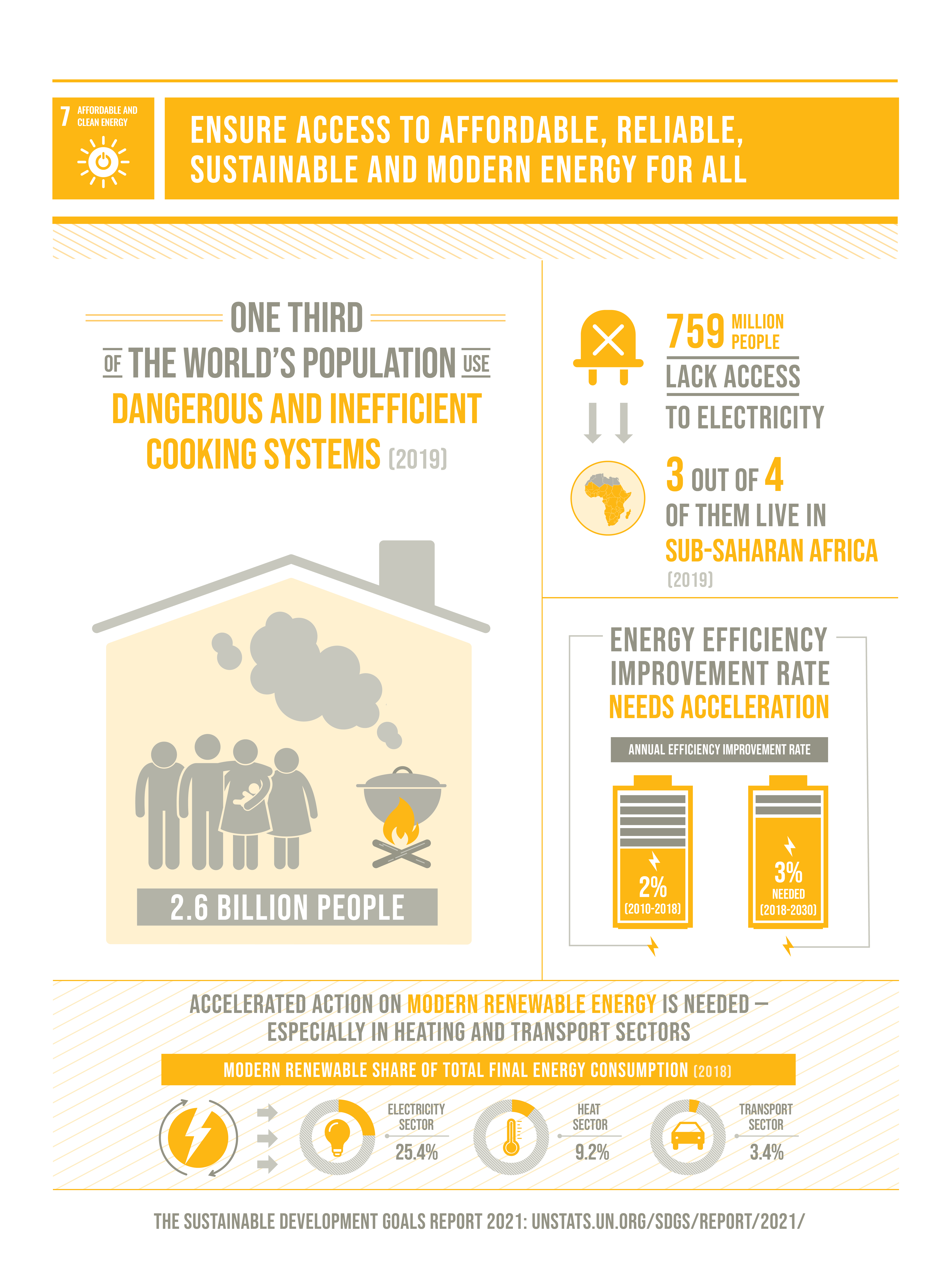



Access to electricity in poorer countries has begun to accelerate, energy efficiency continues to improve, and renewable energy is making impressive gains in the electricity sector.
Nevertheless, more focused attention is needed to improve access to clean and safe cooking fuels and technologies for 3 billion people, to expand the use of renewable energy beyond the electricity sector, and to increase electrification in sub-Saharan Africa.
The Energy Progress Report provides global dashboard to register progress on energy access, energy efficiency and renewable energy. It assesses the progress made by each country on these three pillars and provides a snapshot of how far we are from achieving the 2030 Sustainable Development Goals targets.
Facts and Figures:-
- 13per cent of the global population still lacks access to modern electricity.
- 3 billion people rely on wood, coal, charcoal or animal waste for cooking and heating
- Energy is the dominant contributor to climate change, accounting for around 60 per cent of total global greenhouse gas emissions.
- Indoor air pollution from using combustible fuels for household energy caused 4.3 million deaths in 2012, with women and girls accounting for 6 out of every 10 of these.
- In 2016, the share of renewables increased at the fastest rate since 2012, up 0.24 percentage points, and reached almost 17.5per cent owing to rapid growth in hydropower, wind, and solar.
7.1 By 2030, ensure universal access to affordable, reliable and modern energy services
7.2 By 2030, increase substantially the share of renewable energy in the global energy mix
7.3 By 2030, double the global rate of improvement in energy efficiency
7.A By 2030, enhance international cooperation to facilitate access to clean energy research and technology, including renewable energy, energy efficiency and advanced and cleaner fossil-fuel technology, and promote investment in energy infrastructure and clean energy technology
7.B By 2030, expand infrastructure and upgrade technology for supplying modern and sustainable energy services for all in developing countries, in particular least developed countries, small island developing States, and land-locked developing countries, in accordance with their respective programmes of support
Despite significant progress over the past decade on improving access to electricity, increasing renewable energy use in the electricity sector and improving energy efficiency, the world is still falling short in providing affordable, reliable, sustainable and modern energy for all. Clean and sustainable energy should be at the heart of the COVID-19 response and of efforts to combat climate change.
Global access to electricity increased from 83 per cent in 2010 to 90 per cent in 2019, with an increase in average annual electrification of 0.876 percentage points. The global access deficit decreased from 1.22 billion in 2010 to 759 million in 2019. Despite the significant effort made, there may still be as many as 660 million people without access worldwide in 2030. In addition, the COVID-19 pandemic will impede progress on future electrification.
In 2019, 66 per cent of the global population had access to clean cooking fuels and technologies. For the period 2010–2019, most of the increases in such access occurred in the most populous low- and middle-income countries and territories: Brazil, China, India, Indonesia and Pakistan. People reliant on polluting fuels and technologies are exposed to high levels of household air pollution with serious consequences for their cardiovascular and respiratory systems, increasing their vulnerability to diseases including the COVID-19 virus.
The share of renewable energy in total final energy consumption increased gradually from 16.4 per cent in 2010 to 17.1 per cent in 2018. However, the share of modern renewable sources in total final energy consumption rose by only 2.5 percentage points in a decade, remaining below 11 per cent in 2018. The pandemic is having a mixed impact on renewable energy development across end-use sectors: global electricity demand declined by 2 per cent in 2020 compared to 2019, but the use of renewables for power generation increased by almost 7 per cent year on year.
Global primary energy intensity increased from 5.6 megajoules per dollar of gross domestic product (GDP) in 2010 to 4.8 megajoules in 2018, an average annual rate of improvement of 2 per cent. While early estimates for 2019 also indicate an improvement of 2 per cent, the outlook for 2020 suggests a rate of only 0.8 per cent because of the pandemic. Annual improvement until 2030 will need to average 3 per cent if the Goal 7.3 target is to be met.
International financial flows to developing countries in support of clean and renewable energy reached $14 billion in 2018, 35 per cent lower than in 2017 but 32 per cent higher than in 2010. Hydropower projects received 27 per cent of flows in 2018, while projects relating to solar received 26 per cent, geothermal 8 per cent, wind 5 per cent and multiple or other renewable energies 34 per cent.
Developing countries had a renewable energy capacity of 219 watts per capita at the end of 2019, an increase of 7 per cent over the year but slightly less than the 8.8 per cent expansion in per capita capacity for 2018. Per capita hydropower capacity remained stable in 2019, as total capacity increased in line with population growth during the year at approximately 0.4 per cent. Solar and wind capacities both expanded much faster than population growth, leading to increases in per capita capacity of 22.2 and 11.3 per cent, respectively.
Lack of access to energy may hamper efforts to contain COVID-19 across many parts of the world. Energy services are key to preventing disease and fighting pandemics – from powering healthcare facilities and supplying clean water for essential hygiene, to enabling communications and IT services that connect people while maintaining social distancing.
Countries can accelerate the transition to an affordable, reliable, and sustainable energy system by investing in renewable energy resources, prioritizing energy efficient practices, and adopting clean energy technologies and infrastructure. Businesses can maintain and protect ecosystems and commit to sourcing 100% of operational electricity needs from renewable sources. Employers can reduce the internal demand for transport by prioritizing telecommunications and incentivize less energy intensive modes such as train travel over auto and air travel. Investors can invest more in sustainable energy services, bringing new technologies to the market quickly from a diverse supplier base. You can save electricity by plugging appliances into a power strip and turning them off completely when not in use, including your computer. You can also bike, walk or take public transport to reduce carbon emissions.
Source:- www.un.org